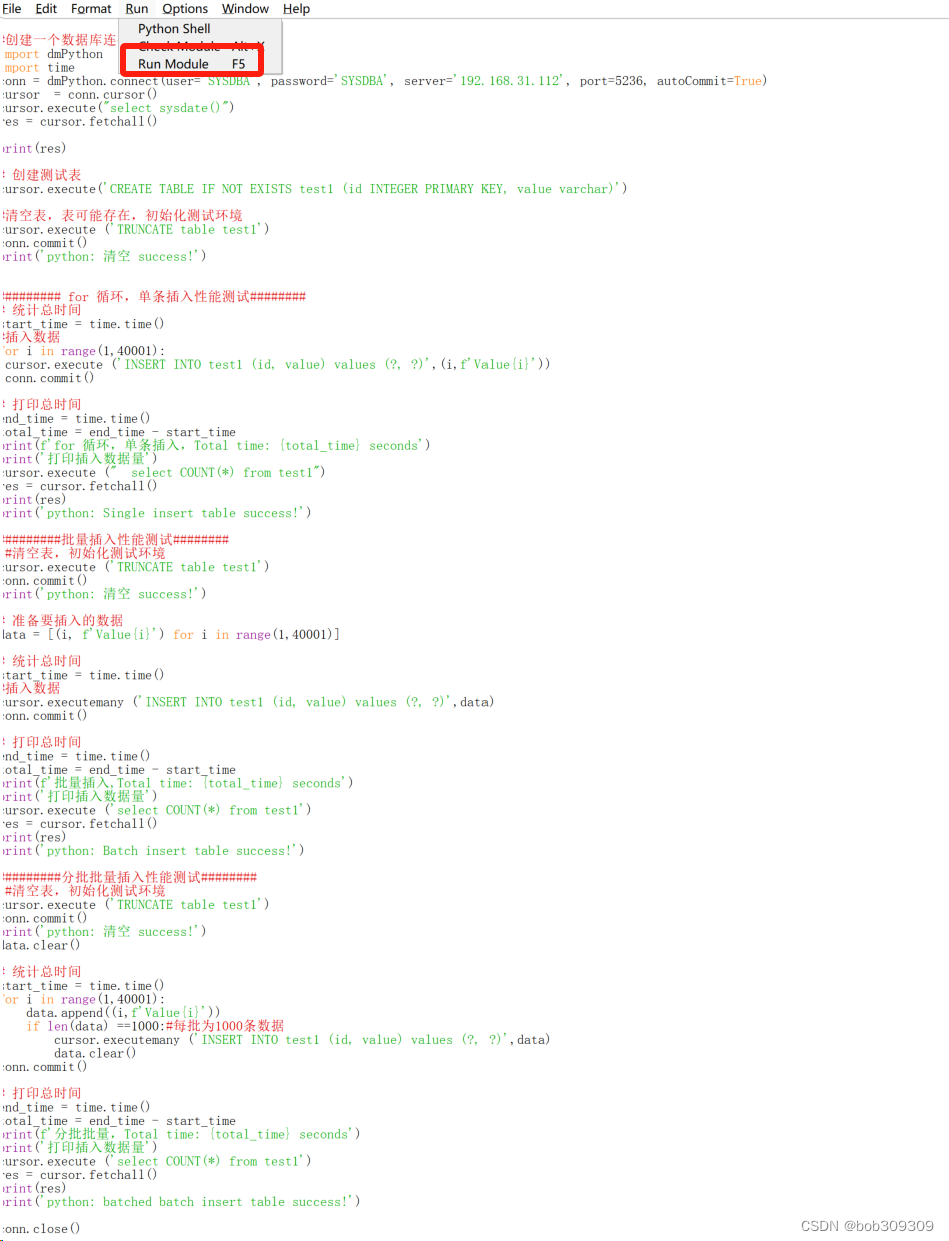python批量插入到达梦数据库的三种方式性能对比

python批量插入到达梦数据库的三种方式性能对比
最近工作中,遇到需要批量导入测试数据到达梦数据库表中。使用python程序,完成一定规模数据插入到达梦数据库表中,尝试了三种方式(for循环单条,批量插入,分批批量插入),对三种数据插入方案,进行了一次性能测试比对,记录一下测试心得
。
环境
Win11+python
虚拟机centos7+DM8数据库
编写python数据导入程序
编写以下python程序,分别实现for循环单条插入,批量插入,分批批量插入数据到DM8达梦数据库,数据量插入4万条,再分别统计三种方式的用时。
#创建一个数据库连接
import dmPython
import time
conn = dmPython.connect(user=‘SYSDBA’, password=‘SYSDBA’, server=‘192.168.31.112’, port=5236, autoCommit=True)
cursor = conn.cursor()
cursor.execute(“select sysdate()”)
res = cursor.fetchall()
print(res)
创建测试表
cursor.execute(‘CREATE TABLE IF NOT EXISTS test1 (id INTEGER PRIMARY KEY, value varchar)’)
#清空表,表可能存在,初始化测试环境
cursor.execute (‘TRUNCATE table test1’)
conn.commit()
print(‘python: 清空 success!’)
######### for 循环,单条插入性能测试########
统计总时间
start_time = time.time()
#插入数据
for i in range(1,40001):
cursor.execute (‘INSERT INTO test1 (id, value) values (?, ?)’,(i,f’Value{i}’))
conn.commit()
打印总时间
end_time = time.time()
total_time = end_time - start_time
print(f’for 循环,单条插入,Total time: {total_time} seconds’)
print(‘打印插入数据量’)
cursor.execute (" select COUNT(*) from test1")
res = cursor.fetchall()
print(res)
print(‘python: Single insert table success!’)
#########批量插入性能测试########
#清空表,初始化测试环境
cursor.execute (‘TRUNCATE table test1’)
conn.commit()
print(‘python: 清空 success!’)
准备要插入的数据
data = [(i, f’Value{i}’) for i in range(1,40001)]
统计总时间
start_time = time.time()
#插入数据
cursor.executemany (‘INSERT INTO test1 (id, value) values (?, ?)’,data)
conn.commit()
打印总时间
end_time = time.time()
total_time = end_time - start_time
print(f’批量插入,Total time: {total_time} seconds’)
print(‘打印插入数据量’)
cursor.execute (‘select COUNT(*) from test1’)
res = cursor.fetchall()
print(res)
print(‘python: Batch insert table success!’)
#########分批批量插入性能测试########
#清空表,初始化测试环境
cursor.execute (‘TRUNCATE table test1’)
conn.commit()
print(‘python: 清空 success!’)
data.clear()
统计总时间
start_time = time.time()
for i in range(1,40001):
data.append((i,f’Value{i}’))
if len(data) ==1000:#每批为1000条数据
cursor.executemany (‘INSERT INTO test1 (id, value) values (?, ?)’,data)
data.clear()
conn.commit()
打印总时间
end_time = time.time()
total_time = end_time - start_time
print(f’分批批量,Total time: {total_time} seconds’)
print(‘打印插入数据量’)
cursor.execute (‘select COUNT(*) from test1’)
res = cursor.fetchall()
print(res)
print(‘python: batched batch insert table success!’)
conn.close()
测试过程
执行程序:

结果显示:

分析总结
测试结果显示:for循环单次插入性能最低效,而分批批量插入,比单次批量插入的性能更高。
分批批量插入性能高于单次批量插入的性能,与我预期不符,查阅达梦数据库相关资料,大概理解了其中原因:
分批插入将大量数据分成小批次进行插入,可以减少数据库的压力,提高插入性能。
分批插入
性能高的几个点
:
可以降低数据库IO:一次插入大量数据时,数据库需要处理大量数据,可能导致IO瓶颈。分批插入可以将数据分成小批次,降低每次插入的数据量,从而降低数据库IO。
可以减少锁竞争:在并发访问的情况下,大量数据同时插入可能导致锁竞争,影响数据库性能。分批插入可以降低锁竞争,提高数据库并发性能。
可以提高插入速度:分批插入可以充分利用数据库的批量处理能力,提高数据插入速度。
达梦技术社区:eco.dameng.com